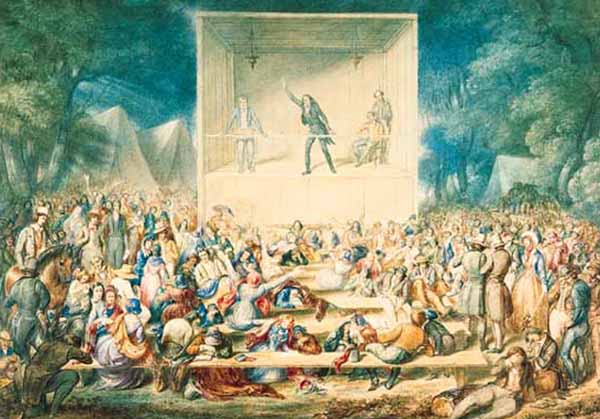The revivals of the early 19th century not only changed the face of American religion, but also spurred the growth of a variety of social reform movements.
From roughly the 1790s through the 1840s, a series of religious revivals took place all across the young but rapidly growing United States. It was called, at the time and since, the Second Great Awakening – the original Great Awakening having occurred in the 1730s and 1740s, as exemplified in the preaching of George Whitefield and Jonathan Edwards. In terms of both the numbers of people involved and the effects on the culture as a whole, the Second Great Awakening far exceeded the First.
The Growth of Evangelical Religion
At its root, the Second Great Awakening was about evangelicalism, the conviction that God’s “good news” of salvation through Christ should be offered to everyone – that being a Christian meant not just quietly accepting that salvation for oneself, but openly encouraging others to accept it as well. For the churches involved, worship became less intellectual and more emotional, with the emphasis changing from understanding God’s will to feeling God’s power within – from simply being “converted” to being “born again.”
The Diversity of American Religion
Led by popular evangelical preachers like Lyman Beecher and Charles Finney, the Awakening brought renewal to the older Protestant churches – Episcopalian, Congregational, Presbyterian, Lutheran – and spurred the growth of newer ones – Methodist, Baptist, Mormon, Adventist. Not only were new denominations appearing on the scene, but all denominations, old and new, were splitting into factions as the spirit of revivalism encouraged a more personal approach to religion. By 1850, it is estimated, roughly one-third of Americans were church members – twice the percentage as in 1776.
Religious Awakening and Social Reform
The Awakening created in its adherents not only a heightened religiosity, but also a heightened sense of social responsibility. The 1830s and 1840s saw the establishment of a huge variety of reform movements beyond church walls: anti-poverty efforts, the spread of public schools and libraries, prison reform, abolitionism, temperance movements, utopian communities, women’s rights movements, reform of working conditions, changes in child rearing – even dietary reforms.
Not everyone saw the Awakening as positive. There was criticism that the evangelical approach to religion was theologically shallow and emotionally manipulative. The reform movements that resulted from it were often controversial, especially those concerned with slavery and emancipation. But there can be little doubt that the Second Great Awakening produced huge changes in American life and contributed in many ways to the development of modern America.
Source:
- Howe, Daniel Walker. What Hath God Wrought: The Transformation of America, 1815–1848. Oxford University Press, 2007.








